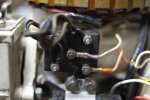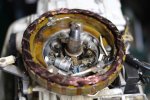Remove the flywheel and check the wiring to the points. Each set should have three wires on the insulated post and the wire terminations should NOT touch anything but the post. The three wires are: 1. wire from hot side of coil, 2. Wire from condenser, and 3. Wire from kill circuit (these are the two wires that look like lamp cord and attach to the blue and white terminals on the engine, assuming magneto ignition.) With battery and coil ignition there should be two white wires.
Be certain you placed the cam with the rotation directional arrow facing up. Putting the cam on upside-down will sometimes prevent spark.
The other side of the coils should be connected to the carrier plate. The carrier plate needs to be grounded to the block by a black wire. This is because the carrier plate is insulated from the block by a plain bronze greased bearing.
While it is unlikely that both condensers are bad it is possible and a bad condenser will prevent spark.
Check that the spark plug wires are solid in the coils and check that the wire inside the boot is not broken. It is a regular steel spring. It does often rust and break right where it is pressed into the wire.
I just noticed that you said the engine has a stator. This would be battery and coil ignition. The stator is part of an alternator which charges the battery. The battery charges the coils to create spark. If the stator wires are scraped to expose the wire and creat a short it will not or should not affect running. Since the rectifier is a one way valve, the battery can not discharge into the shorted stator. the engine should start and run until the battery drops below a critical voltage.
The blue wires from the ignition switch connect to the positive side of the coils. The white wires connect to the negative sides of the coils. With the ignition switch on and the points closed 12 volts flows through the coils to the points through the white wire. The coils build up a magnetic field in the primary windings. When the points open, voltage stops flowing and the magnetic field in that coil collapses, cutting through the secondary windings, creating an high voltage pulse delivered to the spark plug.
SO: with no spark, check that the positive side of the coils are getting 12 volts. check that the white wires are attached to the points and are not shorted or grounded anywhere.
The flywheel gently rubbing against the laminations of the stator is not desirable but generally will do no harm. Rubbing against the wires of the stator is definitely not good and means the hub of the flywheel is worn too big, letting the flywheel sit too low OR---You have not properly set the stator down on the mount and have not adequately tightened the mounting screws.


























